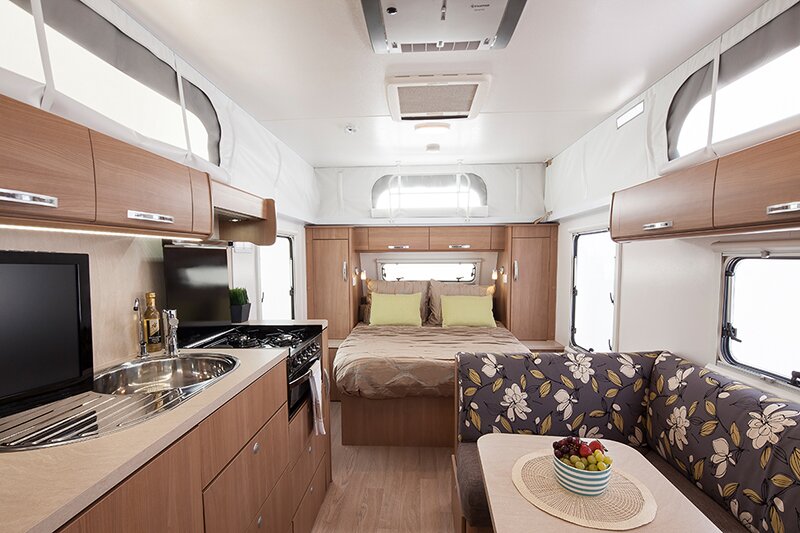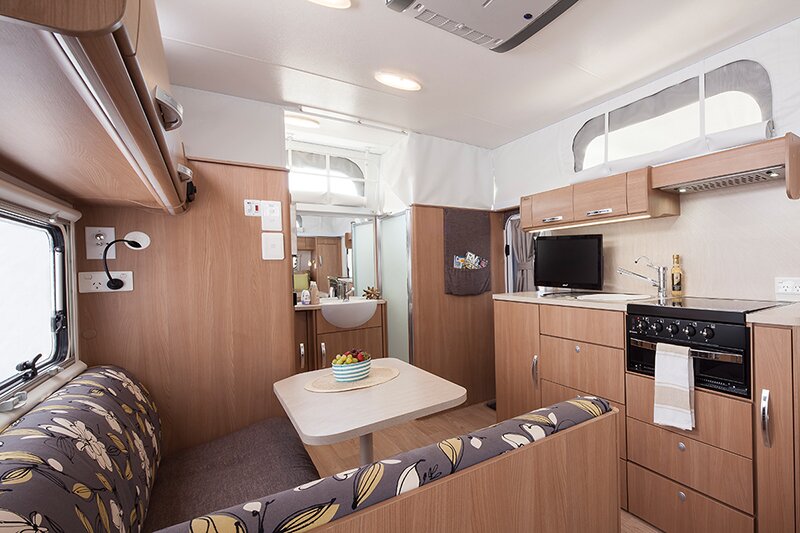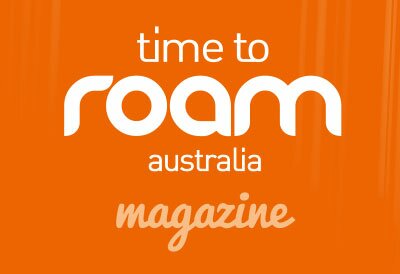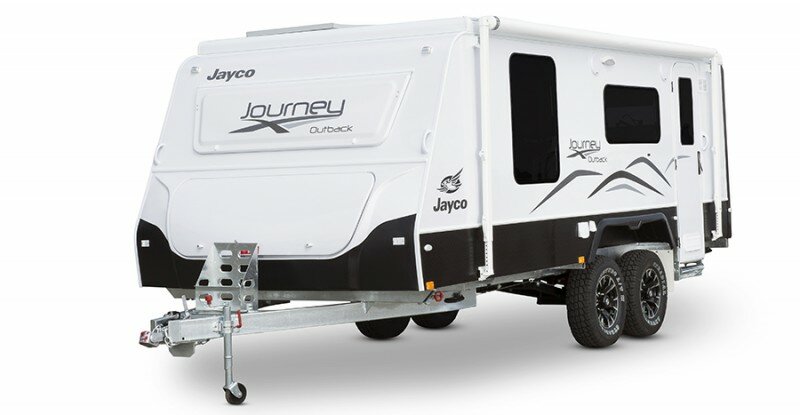In 2014 Jayco combined the best of two models, the Destiny and the Sterling, into a new caravan, the Journey. It’s grown to become the most popular in the range of Jayco’s pop-tops, and continues to find new fans thanks to a line-up of sought-after features.
The Journey range is divided into two basic groups, those designed more for highway touring and those equipped for tougher operations on less accommodating tracks. Designated as the 17.55-8 and -9 or Outback models, these are the biggest sellers in the Journey range.
Jayco’s pop-top vans have always been popular with those looking for a lower roof line for enhanced aerodynamics, fuel consumption or storage reasons. They are also sought after by buyers who don’t want to fork out for a larger tow vehicle.
Today they’re increasingly an option for couples moving up from something like a camper trailer, or those moving up from tent camping and looking for more creature comforts. With good ground clearance in the Outback models, tougher set-up and a smaller travelling profile than most caravans, they can still be taken to many of the places you once sought with your camper trailer or tent.
The Outback kit including Jayco’s popular JTECH independent trailing arm suspension package with heavy duty drawbar (120mm deep instead of 100mm), a front jerry can holder, black checkerplate panelling over the lower portion of the body, external 12-volt power outlet, galvanised rear bumper bar, gas bayonet fitting to the exterior for use with an external barbecue and 120 watt roof-mounted solar panel. These vans have a much better resale value and give you that element of extra flexibility no matter what circumstances might throw at you.
The Outback fitout also introduces larger 235/75R15 tougher all-terrain tyres on alloy rims in place of the touring 185R14 rubber found on the highway models.
The downside to this is the weight increases by an extra 150kg and the ball weight increases by 25kg, although neither is excessive.
Since they have a shower fitted they come standard with a 100 amp-hour gel battery for the water pump, a second 82-litre water tank, and a second 9kg gas bottle to run the water heater unit.

image by: Brett Goldsmith
All of the 17ft vans, including the 17.55-8 and -9, also come equipped with a Truma air conditioning system. These excellent German-made units do a much better job in extreme conditions and are worth having.
Like all Jayco vans, the tandem axle shower-equipped models have a 475kg of carrying capacity to accommodate the extra water.
The fitout provides for a range of features that are worth having. There are 12 internal layout styles to choose from across the range. One of the attributes brought over from the Sterling was the higher walls. This allows for tinted Dometic double glazed windows built-in blinds and insect mesh.
With the larger windows, zip-out panels in the pop-top walls and a roof-mounted skylight over the bed, the interiors of these vans are bright and sunny.
The fully separate all-in-one bathroom across the rear is the stand out feature. It comes with comfortable layout, plenty of storage spaces and the shower has been improved with a single-piece unit eliminating the risk of leaks.
There are a range of bathroom and kitchen options to choose from. The Outback model as tested came without a normal oven to allow for extra storage, but it is an option. There is a microwave, Smev three-burner gas hotplates and single electric hot plate gas stove with griller underneath.
The extra electric hotplate comes in handy, saving gas when mains power is available, as does the dual-mode water heater. The fridge, which was 110 litres capacity in the Sterling, has now gone up to a standard 150 litre three-way unit.
For sleeping, there’s either an island orthopaedic double bed or two singles, with inner spring mattresses. For peace of mind, all the Journey vans are equipped standard with a Camec security door.
While the Outback vans are designed basically for two, there is a $299 option to purchase an additional cushion and baseboard, which converts the dinette into another bed.
A stand out feature certainly not available in the 1970s is the electrical and entertainment systems. Lighting is all LED and completely wireless. This eliminates the risk of any wiring problems and also means you never have to get out of bed to switch off a light – there’s a remote for that. A USB charging point is standard as well as an 18-inch LED television/DVD player with mounting bracket and wind-up antenna. There’s a Fusion CD/radio system, complete with external speakers.

image by: Brett Goldsmith
To complete the outside living experience there’s an optional external shower (with free-standing shower tent if desired) and an external TV socket. To extend your options all Jayco outlets offer an annexe kit.
All the Journey models come with a white Euro-style fibreglass body, with sloping aerodynamic nose. Smart graphics set off the finish and give a sharp style to these vans.
There are so many options to choose from across the range. One certainly worth considering for off roaders is the Coast to Coast Control Panel ($207) which monitors water levels in up to four tanks (two standard plus optional third and waste water tanks) as well as battery charge levels There is also the excellent Al-Ko Electronic Stability Control to keep your van where it belongs, as well as a longer A-frame, Tregg offroad polyblock coupling, and leather seat coverings.
Pop-tops have come a long way since the first humble camper was introduced by Jayco in the 1970s and they remain as popular as ever. The reason for that is undoubtedly due to their value for money in terms of quality, resale value and great list of standard features.
At $41,563 RRP as tested, it is excellent value.
Link: Read the full review and specs in Issue 15 of Time to Roam.
Review by David Cook.






